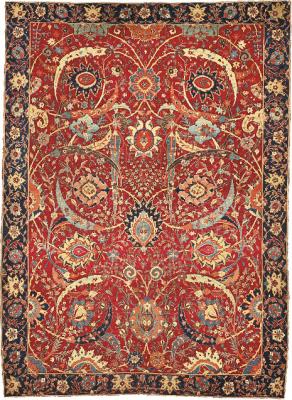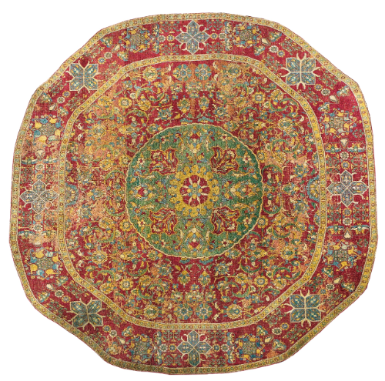New World Record for an Oriental Rug

At one point during Sotheby's-New York June 5, 2013 auction the auctioneer, Mary Jo Otsea, laughed after misstating a bid for $16 million as $16,000. "I'm not used to this" she said, and the crowd laughed with her. By the time the bidding was done a new record for the most expensive Oriental rug in the world had been set with the sale of a 17th century Persian Kerman for $33,765,000.
The Clark Sickle Leaf Vase Carpet (6'9" x 8'5") that has entranced collectors and scholars for decades was one of 25 classical 16th and 17th century pieces from the collection of the "Copper King" in New York at Sotheby's (listing) . The auction estimate for the rug of $5,000,000 to $7,000,000 was well below the prior record but passed well into uncharted territory for an Oriental rug to finish at more than three times the previous benchmark.
The rugs were owned by the Corcoran Gallery of Art in Washington, DC but are best known for being part of the famous collection assembled by Senator William A. Clark (1839-1929). The Senator was known both for his great wealth and a political scandal that contributed to the passing of the 17th Amendment. He was one of the richest Americans of his time having made his money as one of the "Copper Kings" of Montana before being elected to the Senate of the United States.

The rug collection has been in storage since being part of an exhibit in 1948 but all the pieces have all found new homes. The auction total for the entire collection was $43,764,750 surpassing estimates for 24 of the 25 carpets including the 14 foot wide by 44 foot long Lafões Carpet which had an estimate of $800,000 to $1 Million but fetched more than $4.6 million.

However, the news of the day remains the gorgeous piece first purchased from New York dealer of art level textiles Vitall Benguiat by Senator Clark and his wife Huguette around the turn of the century for their Fifth Ave mansion. The tremendous vitality of this carpet’s design is achieved through its highly complex network of swirling vines, which intertwine and overlap each other and the flowering or fruit-laden branches. The name given to the piece refers to the most distinctive part of this pattern the Sickle Leaf design with interspersed Vases. It has a wool pile of asymmetrical knots with a foundation of cotton warps and a combination of wool and silk used in the wefts.
In the end it is fair to say no one is used to this. Perhaps it is the dawn of a new age in the appreciation of classic design. If one considers the recent results of public auctions and the market for antique carpets it certainly appears to be on the rise with investors seeing long term value in hand knotted carpets and related textiles.
Peruse the results of the world's greatest ever Oriental carpet auction.

